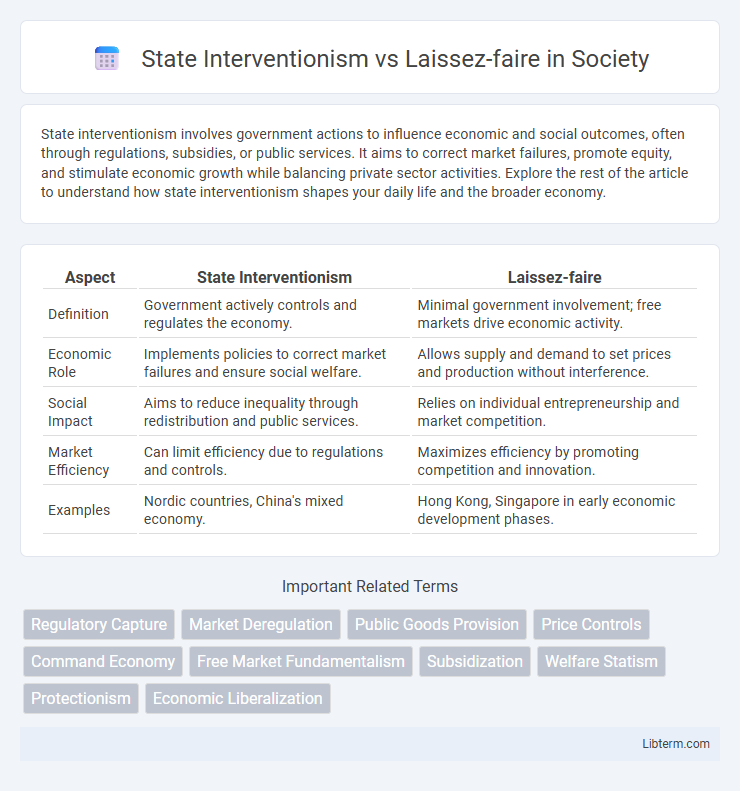State interventionism involves government actions to influence economic and social outcomes, often through regulations, subsidies, or public services. It aims to correct market failures, promote equity, and stimulate economic growth while balancing private sector activities. Explore the rest of the article to understand how state interventionism shapes your daily life and the broader economy.
Table of Comparison
| Aspect | State Interventionism | Laissez-faire |
|---|---|---|
| Definition | Government actively controls and regulates the economy. | Minimal government involvement; free markets drive economic activity. |
| Economic Role | Implements policies to correct market failures and ensure social welfare. | Allows supply and demand to set prices and production without interference. |
| Social Impact | Aims to reduce inequality through redistribution and public services. | Relies on individual entrepreneurship and market competition. |
| Market Efficiency | Can limit efficiency due to regulations and controls. | Maximizes efficiency by promoting competition and innovation. |
| Examples | Nordic countries, China's mixed economy. | Hong Kong, Singapore in early economic development phases. |
Defining State Interventionism
State interventionism refers to government actions aimed at regulating or directly influencing economic activities to correct market failures, promote social welfare, and ensure economic stability. This approach involves policies such as subsidies, tariffs, public ownership, and regulatory frameworks designed to guide market outcomes and protect public interests. In contrast to laissez-faire, state interventionism prioritizes active government involvement over minimal interference in the economy.
Understanding Laissez-faire Principles
Laissez-faire principles advocate minimal government interference in economic activities, emphasizing free markets and individual entrepreneurship as drivers of innovation and wealth creation. This approach relies on the belief that market forces, such as supply and demand, naturally regulate prices and resource allocation more efficiently than state intervention. Understanding laissez-faire economics highlights the advantages of economic freedom, lower regulation costs, and the promotion of competition that can lead to greater consumer choice and economic growth.
Historical Context and Evolution
State interventionism in economics emerged prominently during the Great Depression of the 1930s, when governments worldwide increased regulatory oversight and public spending to stabilize markets and stimulate growth. Laissez-faire economic principles, advocating minimal government interference, dominated the 19th and early 20th centuries, aligning with classical liberalism and industrial capitalism. The post-World War II era saw a blend of both approaches, with Keynesian policies promoting state intervention alongside market mechanisms, leading to diverse economic systems evolving over time.
Key Differences Between the Two Approaches
State interventionism emphasizes government involvement in the economy through regulations, subsidies, and public services to correct market failures and promote social welfare. Laissez-faire advocates minimal government interference, relying on free markets to regulate supply, demand, and prices, fostering competition and innovation. Key differences include the role of government control, the extent of market freedom, and approaches to economic inequality and resource allocation.
Economic Efficiency and Market Regulation
State interventionism enhances economic efficiency by correcting market failures, such as externalities and public goods, through targeted regulations and fiscal policies that optimize resource allocation. Laissez-faire promotes market self-regulation, relying on supply and demand dynamics to drive efficiency but often lacks mechanisms to address monopolies, information asymmetry, and social welfare concerns. Empirical studies indicate mixed outcomes, with interventionist economies showing improved stability and equitable growth, while laissez-faire systems tend to maximize short-term productivity and innovation under ideal competitive conditions.
Social Equity and Wealth Distribution
State interventionism promotes social equity by implementing progressive taxation, social welfare programs, and regulations that reduce income inequality and redistribute wealth. Laissez-faire economics prioritizes minimal government interference, often resulting in greater wealth concentration but potentially higher economic growth and individual entrepreneurial freedom. Empirical studies show that countries with moderate state intervention tend to achieve more balanced wealth distribution and lower poverty rates compared to purely laissez-faire economies.
Impact on Innovation and Entrepreneurship
State interventionism, through regulations, subsidies, and public investment, can provide critical support for innovation and entrepreneurship by reducing market uncertainties and fostering research and development. In contrast, laissez-faire policies promote entrepreneurial freedom and risk-taking by minimizing government control, which can lead to rapid innovation driven by competitive pressures. Empirical studies show that balanced intervention, blending strategic public support with open markets, tends to optimize innovation output and entrepreneurial growth.
Case Studies: Global Examples
China's state interventionism showcases significant government control in sectors such as technology and finance, driving rapid economic growth and global competitiveness. In contrast, the United States exemplifies laissez-faire principles through minimal regulatory interference, fostering innovation and market-driven expansion in industries like technology and energy. European countries like Germany balance both approaches with strategic state involvement in key industries alongside robust free-market mechanisms, promoting stability and sustainable development.
Criticisms and Common Misconceptions
State interventionism is often criticized for causing market inefficiencies, stifling innovation, and increasing government debt through excessive regulation and spending. Laissez-faire policies face misconceptions that they always promote economic freedom and prosperity, ignoring instances where lack of regulation can lead to monopolies, market failures, and social inequalities. Both approaches are frequently debated, with critics of interventionism pointing to bureaucratic overreach, while opponents of laissez-faire highlight risks of unregulated market volatility and exploitation.
Finding a Balanced Economic Approach
State interventionism promotes government involvement to correct market failures, ensure social welfare, and stabilize economic cycles, while laissez-faire advocates minimal interference, trusting free markets to allocate resources efficiently. Finding a balanced economic approach involves implementing strategic regulations that prevent monopolies and protect consumers without stifling innovation or market competition. Economies combining targeted state policies with entrepreneurial freedom tend to achieve sustainable growth, reduced inequality, and enhanced resilience against financial crises.
State Interventionism Infographic

 libterm.com
libterm.com